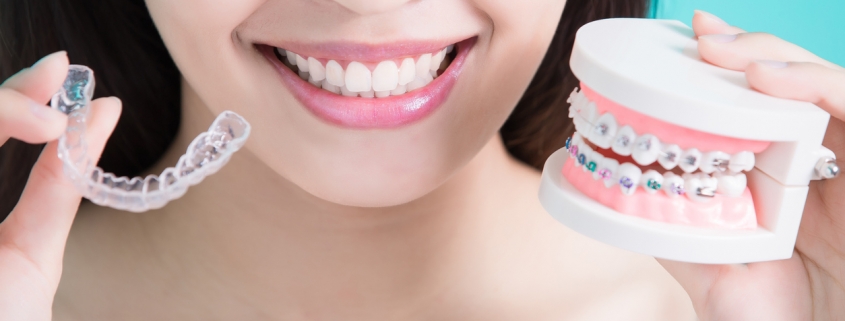Invisalign or Traditional Braces?
It’s a fact of life that perfect teeth do not come to the majority of us naturally. In fact, there’s an estimated 75% chance that a child between the ages of 10-13 will need some sort of orthodontic intervention in their life. But braces are not just for children anymore. Adult braces are on the rise as well for those who never had the opportunity as a child, or for the small percentage who neglected to properly wear their post-braces retainer and their teeth shifted back to their previous state. No matter which category you fall under, there is help out there, and with the rise and advancement of technology, you now have a choice: traditional braces or Invisalign? By the end of this article, you will hopefully have a clear, informed decision on which to choose.
Let’s start with traditional braces. These are metal brackets that sit on the surface of the tooth and are connected by a wire, but have come a long way from being the famous “metal-mouth” braces of the past. The ones nowadays have smaller brackets which are less noticeable, and have the option of having an “archwire”–a wire that is heat activated by your body’s natural heat to make the process of moving your teeth not only faster, but less painful as well.
Pros of Traditional Metal Braces:
- Less treatment time
- Able to correct severe cases
- For the kids and fun-loving adults: interchangeable, colourful elastic bands
- No risk of losing them
- Inexpensive
- Suitable for all ages
Cons of Traditional Metal Braces:
- Very noticeable for those concerned with this
- Time consuming to clean around
- Food restrictions: gum, popcorn, caramel candies, anything that is really sticky or hard is not recommended as they can damage the braces
- Have the potential to irritate or cut the inside of your lips and cheeks
There is a non-metal version in the traditional brace family where they use ceramic instead of metal. Ceramic braces are identical to the metal ones in terms of shape and their function, but the brackets and wires are clear or tooth coloured for a more subtle appearance. However, they come with their own pros and cons.
Pros of Ceramic Braces:
- Less noticeable
- Lessen the potential to cut the inside of the lips and cheeks
- Less treatment time (the same as traditional metal)
- No risk of losing them
Cons of Ceramic Braces:
- Unable to be used for very severe cases
- More expensive than the metal variety
- Difficult to maintain–high chance of staining so frequent brushing is a MUST
- Not recommended for children or young teenagers
The third and final option in the traditional brace family are lingual braces, also known as incognito or hidden braces. While traditional braces are placed on the outside of the teeth, lingual braces are fitted behind the teeth for a completely hidden appearance. As with everything, they come with their own unique benefits and challenges.
Pros of Lingual Braces:
- Completely unnoticeable
- Suitable for all ages and most patients
- Less treatment time (same as metal and ceramic)
- No risk of losing them
Cons of Lingual Braces:
- Tongue irritation from constant contact
- Possible speech impediment (only lasts about 2-3 weeks)
- Hygiene and cleanliness issues (it’s much harder to see trapped food)
- Costly
Not a huge fan of having something metal constantly in your mouth and limiting your food choices? Luckily, there is a removable and cost-effective option called Invisalign. Becoming one of the most popular choices for tooth correction nowadays, Invisalign is more accessible than ever. To see if it is right for you, here are some of the pros and cons that come with this treatment:
Pros of Invisalign:
- Completely unnoticeable
- Comfortable to wear
- Able to remove during meals
- Affordable*
- Easy to clean and maintain
Cons of Invisalign:
- Expensive*
- Inconvenient for busy adults/teens
- 22 hour/day requirement
- Tooth discomfort after each new set
*Affordability varies as the cost for Invisalign is on a case to case basis. The more severe a correction needs to be, the more costly they will be as it is not covered by dental insurance. However with Invisalign becoming more and more popular, Newbury Smiles has frequent promotions to make it more accessible to all clients. A quick consultation will help map out the exact costs and what to expect.
Hopefully this guide has given you a better insight into the world of tooth alignment correction. Please note that not all benefits and cons are listed here and you may have a different experience than others as what works for one person may not work for you. Your dentist will be able to determine which is best for you based on a number of factors, and can answer any questions you may have.
To set up a free consultation, please contact Dr. Sam Saddat and his team at +1 805-499-3691

